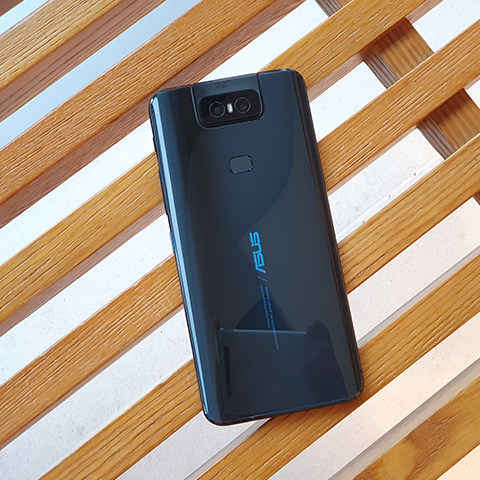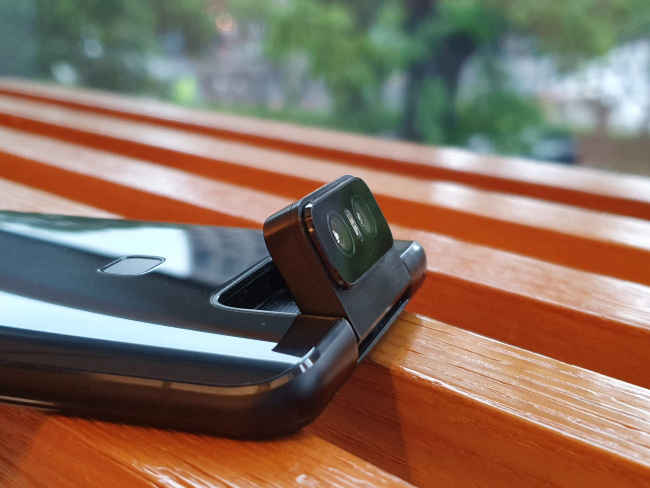

If 2018 was the year of the notch in smartphones, 2019 is turning out to be the year when OEMs race to remove the notch and put the front camera on a mechanical unit to stretch the screen all the way to the edges. Vivo and Oppo started the trend of pop-up and mechanical sliders and we have already seen Xiaomi, Samsung and Honor embrace the new design. It’s a nifty way to get around the notch, but it isn’t without its drawbacks. On Thursday, Asus also ditched the notch that it introduced in the Zenfone 5z amidst much fanfare at MWC last year, to offer a unique solution for a bezel-less display on the Zenfone 6. It’s the successive flagship from the Taiwanese computer giant and it pushes the boundaries when it comes to the smartphone camera.
We spent some time with a pre-production unit of the Asus Zenfone 6 at the company’s headquarters in Taipei, a few weeks before its launch. Asus let us play around with the phone long enough to register our first impressions it.
Let’s start with the most interesting aspect of the phone. The cameras. The Zenfone 6, like the Samsung Galaxy A80, features a camera module that flips over from the back to become the front camera. Like the Galaxy A80, it’s also fitted with the 48MP Sony IMX 586 sensor along with a 13MP ultra-wide camera with 117-degree field of view. The primary camera is fitted with an f/1.79 aperture lens with 0.8um pixel pitch and PDAF while the secondary camera has real-time distortion correction algorithm. While India is no stranger to large-sensor and ultra-wide cameras, it’s the camera module itself that makes the Zenfone 6 unique.


The camera module flips over from the back to the front and lets you control the angle you want it to remain at. It uses a customised stepper motor with a proprietary gear box that generates two times more torque as compared to the regular pop-up modules. The extra power allows the camera module to flip over much faster, and also offer granular control over the angle you want to keep the camera at. Achieving the feat required some tricky innovation from Asus. The module itself is made of an amorphous alloy that Asus calls “Liquid Metal” and the module is the largest component ever made using the material. Inside the module is a gravity sensor and a hall sensor (measures magnitude of magnetic fields), along with 32 signal cables and 17 power cables. It's a big chunk containing the gearbox and the sensors of course. Putting it inside the chassis where there's anyway a space crunch with a large battery and all other components was tough. To fit it in, Asus had to engineer the PCB into two pieces which are then layered on top of one another. It's a two-piece PCB that's fit in one dimension. Doing that, Asus managed to achieve a higher component area that even the Galaxy S10+ (which is no stranger to packing extra sensors and modules) even with a smaller PCB footprint as the S10+.
It's easier to appreciate the Zenfone 6 knowing the kind of engineering that was required to build this, but we were left scratching our heads, as to what was the purpose of the whole exercise. On the screen, you get a slider button that lets you control the angle of the flip camera. The module then can be positioned in weird angles or can be used in one fluid motion like taking a sweeping panorama, both vertically and horizontally. But for the regular photos, the angular camera module serves the same purpose that holding the phone in that very angle will provide. Maybe in videos, it's far more useful. The module offers the ability to take tilt shots without moving the phone, although the placement was not really conducive to shoot videos of devices like we do for our YouTube videos.
The camera can track objects in the frame where once you select the object, the module moves around and follows it, keeping the object in the frame. Our pre-production unit did give a glimpse of it working, but it was far from perfect. Most of it's usefulness centers around the ability to offer the same camera on both the front and back. As a result, you not only have the ability to take 48MP selfies but also use the ultrawide angle camera to take group selfies. And for that, the camera is super quick to flip over.
Then there are a bevy of software-centric camera features, nothing that's really new, but seemed to work as advertised. The Zenfone 6 camera offers an HDR+ Enhanced and a Super Night Mode, both of which uses mutli-frame processing, the former to improve dynamic range and reduce ghosting, and the latter to cut down noise and improve the exposure range.
Long story short, the Zenfone 6 camera sounds and looks really cool, but we're yet to find compelling use case scenarios for the precise tilt offered by the camera module.
The rest of the Zenfone 6 is basically like every other 2019 flagship. There's the Snapdragon 855 under the hood along with to 8 gigs of LPDDR4X RAM and 256 gigs of UFS 2.1 onboard storage. This was also the first Snapdragon 855-powered phone this writer had the chance to use. We did run a few benchmarks while the device was with us to see where the numbers stack up. Note that this is a pre-production unit and scores will likely differ in the retail units. But still, we got a ballpark number for the next-gen flagship device.
On AnTuTu, the Zenfone 6 scored 352664 while on Geekbench Single core and multi core-tests, it scored 3539 and 10793. On 3DMark Slingshot, the Zenfone 6 scored 6868. All these numbers are expectedly higher than the previous Zenfone 5z. But the phone also managed to beat the OnePlus 6T, which was the fastest Snapdragon 845-powered phone we tested last year.
The Zenfone 6 also offers a triple-slot which should especially be useful in markets like India. Despite everything, Asus also managed to cram the same massive 5,000mAh battery in the phone. It charges using a Quick-Charge 4.0-certified charger that tops up the device with 18W of power. Here too Asus had the choice of offering a 40W fast charger, but refrained claiming fast charging degrades the battery over time and causes swelling. We’re yet to see that happen in the Huawei Mate 20 Pro we’ve been using since last year which also has 40W fast charging.
There are dual speakers but aren’t arranged in stereo output. Instead, they are paired with two smart amplifiers. You also get a hi-res earphone bundled with the device which supports DTS Headphone X 7.1.
The whole exercise of engineering a flip camera module was to ensure the screen stretches all the way to the edges. The display, as a result, grabs all the attention up front. It’s not completely bezel-free as there is a visible lower lip, but the panel is bright enough to mask it when you’re watching a video. Asus managed to put a 6.4-inch IPS LCD display in a similar footprint as the Zenfone 5z. It covers 92 percent of the front fascia and offer over 600 nits of brightness with 100 percent DCI-P3 colour space coverage. It’s not an HDR-certified panel even though screen elements looked fairly sharp with saturated colours.
The rear panel is made of 3D curved glass which is reinforced with nano-materials for durability. The Zenfone 6 will be offered in two colour variants — Twilight Silver and Midnight Black. Neither of them have the concentric circle design that was the standard in Asus smartphones for the past few years. Instead, the curved glass back reflect light in various angles. The display on the front is protected by Corning Gorilla Glass 6. It’s also quite hefty at 190 grams.
On the software side, Asus has kept things at a bare minimum. It does run on a custom ZenUI 6 interface based on Android 9, but it also resembles stock Android closely. Asus spent a good ten minutes of the briefing to explain why using pure stock Android wasn’t the best idea as their own software has multiple optimisations in place that makes frequently used apps launch faster. Asus has its own algorithm which it calls Optiflex, that's used for intelligent memory management to choose which apps to keep pre-loaded in the memory and which ones to start cold. During our time with the phone, we faced no apparent stutter or lag in the interface. However, it needs more intensive usage to determine how smooth the UI really is.
Developers will be interested in the fact that the Zenfone 6 also supports Android 10 Q Open Beta 3 and it will also receive the update to Android R down the line. There is 43 percent lesser bloatware on the phone as compared to the Zenfone 2 (stats shared by the company) and this time around, Asus is packing a dedicated ‘smart key’ hardware button, that can not only trigger Google Assistant but can also be customised to launch specific actions like turning on Do Not Disturb, flashlight, screenshot and the likes.
The Asus Zenfone 6, when I first picked it up, felt really interesting. I was primed about the engineering feat before I got my hands on a unit, and was keen to see how it all shapes up. The Zenfone 6, from an engineering standpoint, is a marvel to look at. But after using it for an hour or so, it felt like any other Android flagship available in 2019. All-screen design, a mechanical camera, large battery and fast performance. You’re not missing out on anything, except perhaps an assurance of water resistance, but that’d have been difficult considering the device has movable parts inside. I’m also skeptical of the camera. It could attract dust and over time stop working, and there’s a high probability of water damage if it’s exposed to heavy rainfall. More than innovation, I’m looking at the flip camera module as a way to save costs by not going for an additional camera up front, but the R&D team likely must have offset the costs. As a result, no matter how cool the flip camera module looks and functions, it’s unique use-cases are quite thin at this point. Perhaps the company can work on offering more features to do with the free angular movement of the module, but as of now, you’re only limited to a handful of features which are rarely used. As a smartphone, the Asus Zenfone 6 encompasses every element of a high-end device and stops short at being an out-and-out flagship for the lack of an IP rating and a high-resolution display. The phone is expected to launch later this year in India, and when it does, we’ll have our detailed reviews and comparisons out. Stay tuned!
Asus paid for the writer's travel and stay to Taipei for the pre-launch briefing.